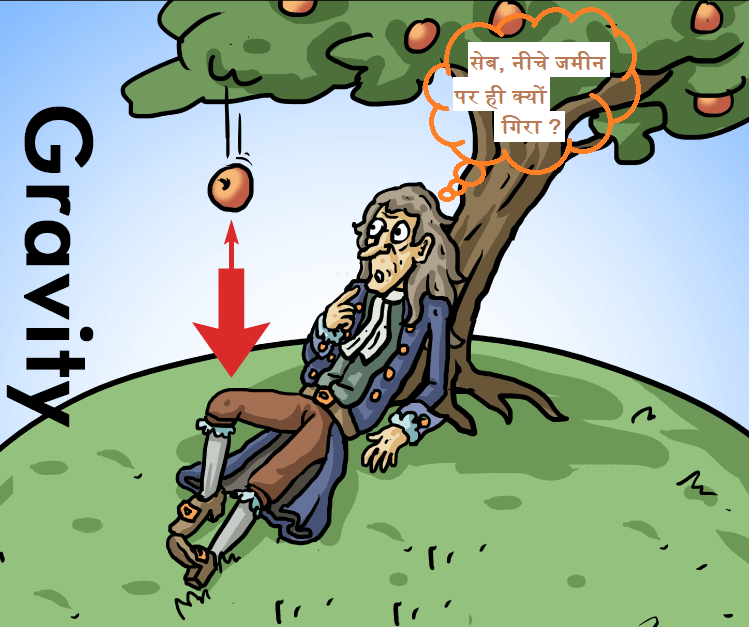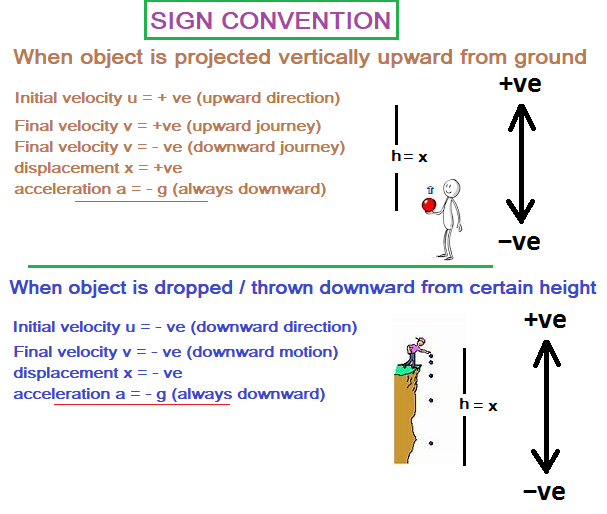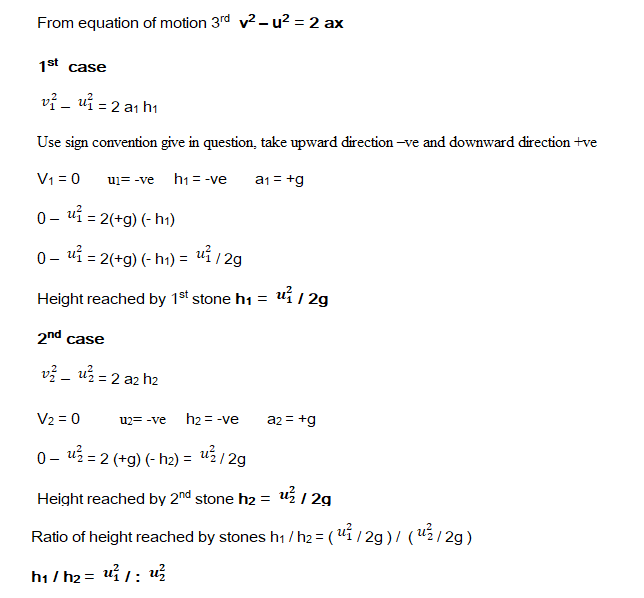Motion under Gravity
Table of Contents
Free Fall:
If a body is projected vertically upward and moves under the influence of gravitational force only then such type of motion is called “Motion under Gravity” or “Free Fall.”
Acceleration due to gravity:
- Acceleration of a free falling body is called acceleration due to gravity.
- Acceleration due to gravity is a vector quantity and its direction is always downward (towards centre of earth).
- The average value of acceleration due to gravity on the surface of earth is 9.81 m/s2

Equations of motion applied to motion under Gravity:
While solving problems related to “Motion under Gravity”, equations of motion are used. Acceleration ‘a’ in these equations is equal to the acceleration due to gravity (a = g).
v = u + at ………….. (1)
x = ut + ½ at2 ………….. (2)
(v2 – u2) = 2ax ……….(3)
Sign convention:
Equations of motion are used while solving problems related to motion under gravity. It is very important to remember that we must use a sign convention according to which quantities directed upwards and rightwards are taken as positive and those downwards and leftwards are taken as negative, or vice-versa.

Questions and Answers
Example 1: A stone is dropped from a height of 50m and it falls freely. Calculate the (i) distance travelled in 2 s, (ii) velocity of the stone when it reaches the ground, and (iii) velocity at 3 s i.e., 3 s after the start.
Ans: Given: u = 0 (Since body is dropped)
(i) Distance travelled, x = ? at t = 2s
from equation of motion (2) x = ut + ½ at2
x = 0 + 0 – ½ gt2 = –½ × 9.8 × (2)2
= –19.6 m
ii) At the ground S = – 50m,
Using equation of motion (3),
v2 = u2 + 2a S
= 0 + 2 (–9.8) (–50 )
v = 9.9 m/s
iii) Using v = u + at, at t = 3s, we get
∴ v = 0 + (–9.8) × 3
v = –29.4 m/s
Example 2:Two stones are thrown vertically upward simultaneously with their initial velocity u1 and u2 respectively. Prove that the height reached by them would be in the ratio of u12: u22.
Ans:

What do you mean by negative acceleration?
Answer : If direction of acceleration is opposite to the direction of velocity, then body have negative acceleration. For example: When we apply break there is negative acceleration or retardation.
Is it possible that a body moving at a constant speed is still accelerating?
Answer: Yes, if a body is moving in a circular path, its speed may be constant, but due to a change in direction, its velocity changes, and hence the body accelerates.
What is acceleration?
Answer: Acceleration refers to the rate at which an object’s velocity changes over time. It is a vector quantity that takes into account both the magnitude and direction of the change in velocity.
What is motion under gravity?
Answer : Motion under gravity refers to the movement of an object influenced by the force of gravity acting upon it. It is the motion exhibited by objects falling freely or moving vertically in the Earth’s gravitational field.
What is the acceleration due to gravity?
Answer : The acceleration due to gravity, denoted as “g,” is the acceleration experienced by an object in free fall near the Earth’s surface. On the surface of the Earth, the average value of acceleration due to gravity is approximately 9.8 meters per second squared (m/s²).
What is the direction of acceleration in motion under gravity?
Answer : In motion under gravity, the acceleration always acts vertically downward. This means that the acceleration due to gravity points towards the center of the Earth.
How is the velocity of an object changing during free fall?
Answer : During free fall, the velocity of an object changes due to the constant acceleration of gravity. The object’s velocity increases as it falls.
How is the distance traveled by a freely falling object related to time?
Answer : The distance traveled by a freely falling object is directly related to the square of the time. In other words, the distance is proportional to the square of the time squared (d ∝ t²).
Can objects of different masses fall at different rates?
Answer : In the absence of air resistance, objects of different masses will fall at the same rate. This is known as the principle of equivalence or the “Galileo’s experiment.” However, in real-world scenarios with air resistance, the rate of fall can vary for objects with different masses and surface areas.
What is the relationship between mass and the acceleration due to gravity?
Answer : The acceleration due to gravity is independent of the mass of an object. According to the equivalence principle, all objects, regardless of their mass, experience the same acceleration due to gravity in a vacuum.
Can motion under gravity occur on planets other than Earth?
Answer : Yes, motion under gravity can occur on any celestial body with sufficient mass to exert a gravitational force. The acceleration due to gravity will vary depending on the mass and radius of the celestial body. Therefore, the motion under gravity on other planets or moons will have different characteristics than on Earth.